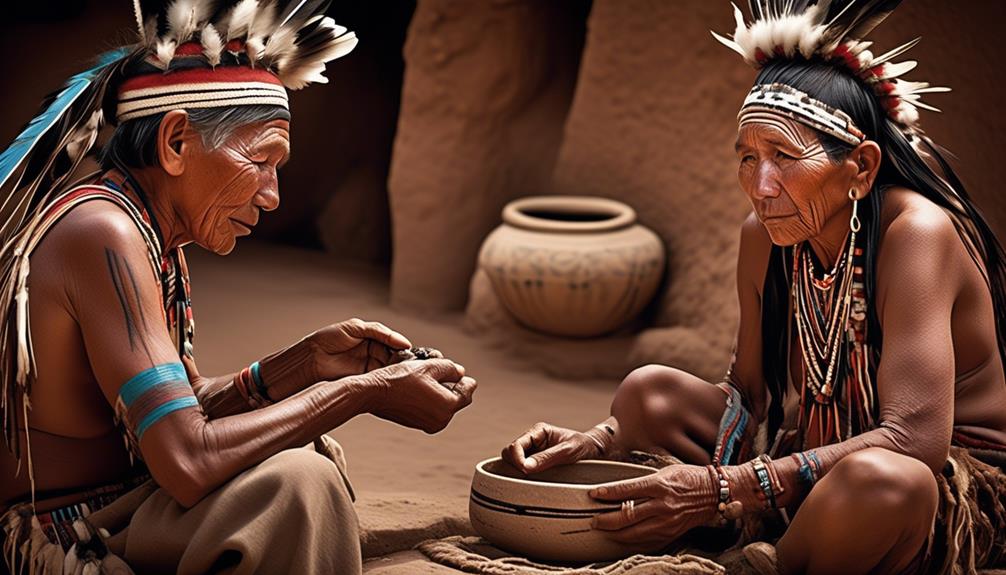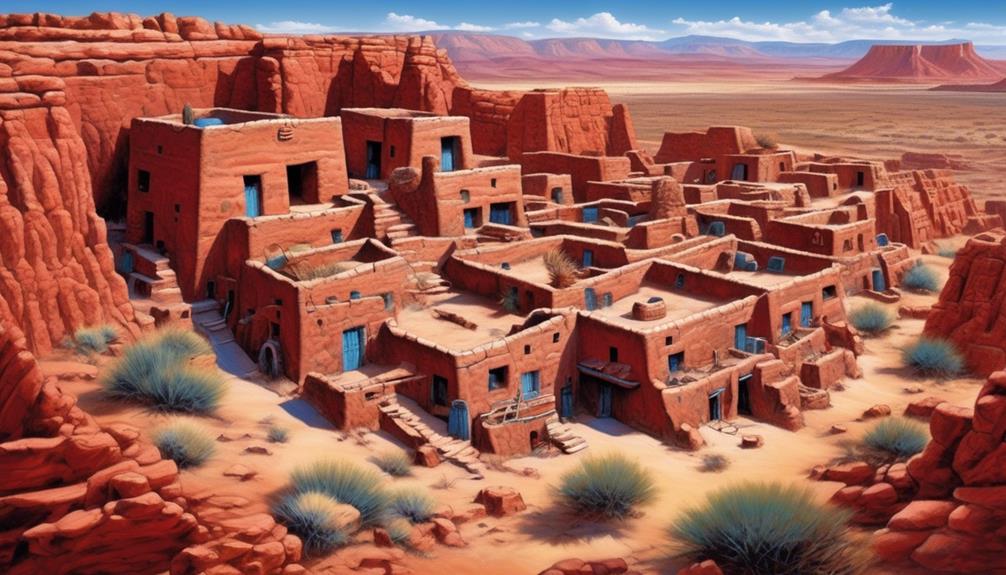The Hopi tribe, as well as other indigenous communities, have created unique techniques for self-protection, demonstrating their deep bond with their surroundings and cultural legacy.
The ways in which the Hopi tribe protected themselves from external threats offer valuable insights into their resourcefulness and resilience.
Key Takeaways
- The Hopi tribe used traditional weapons such as bows and arrows, spears, and clubs to defend themselves.
- They built defensive fortifications using ancient stone dwellings and strategically leveraged natural landscape features for their defense.
- The Hopi tribe employed strategic planning and tactics, including lookout points, knowledge of enemy movements, and creating barriers with rock formations and rugged landscapes.
- They practiced community defense and alliances through tribal alliances, conflict resolution through traditional methods and councils, and shared responsibility among community members for the protection and well-being of the community.
Traditional Weapons
The Hopi Tribe's traditional weapons, such as the bow and arrow, spear, and club, were essential tools for hunting and self-defense. The mastery of archery skills was highly valued among the Hopi people, as it allowed for accurate and efficient hunting of game for sustenance.
The bow and arrow, crafted with precision and care, enabled the Hopi to engage in long-range combat and hunting, showcasing their expertise in archery. Additionally, the spear served as a versatile weapon, useful for both hunting and hand-to-hand combat. Its design and construction were tailored to the specific needs of the tribe, reflecting their deep understanding of effective weaponry.
In close combat, the Hopi relied on hand-to-hand combat techniques, utilizing clubs and other melee weapons. These tools were crafted with durability and striking power in mind, reflecting the Hopi's understanding of close combat dynamics.
The traditional weapons of the Hopi Tribe weren't only instruments of defense but also emblematic of their resourcefulness and adaptability in the face of diverse challenges.
Defensive Fortifications

Crafting defensive fortifications was a natural extension of the Hopi Tribe's mastery of traditional weapons, showcasing their strategic approach to protection and security. Defensive architecture played a pivotal role in the Hopi Tribe's defensive strategies, with structures like the ancient stone dwellings at places such as Old Oraibi serving as both homes and defensive positions. These architectural marvels not only provided shelter but also offered strategic advantages for defense during conflicts. The historical significance of these fortifications extends beyond their defensive purpose, as they stand as testaments to the ingenuity and resilience of the Hopi people throughout centuries of adversity.
Indigenous tactics were also central to the Hopi Tribe's defensive fortifications, with the use of natural landscape features such as cliffs and mesa tops being leveraged for defensive advantage. The strategic positioning of these fortifications within the rugged terrain allowed the Hopi to defend their lands effectively while also preserving their cultural heritage. The integration of indigenous tactics into their defensive strategies underscores the deep connection between the Hopi Tribe and their ancestral lands, reflecting their commitment to cultural preservation.
Strategic Planning
Employing meticulous strategic planning, the Hopi Tribe adeptly orchestrated their defensive measures to safeguard their ancestral lands. Their strategic defense was marked by a deep understanding of their terrain, knowledge of enemy movements, and the effective use of military tactics.
The tribe strategically positioned their lookout points on elevated areas, enabling them to monitor the surrounding landscape for any potential threats. By doing so, they could detect approaching enemies early and prepare their defenses accordingly.
Furthermore, the Hopi Tribe employed military tactics that played to their strengths, such as their expertise in utilizing natural resources for defense. They strategically utilized natural rock formations and rugged landscapes to create barriers, impeding the progress of any invading forces.
Moreover, their strategic planning involved the creation of hidden pathways and escape routes, allowing them to outmaneuver their enemies when necessary.
Community Defense

Meticulously planned defensive strategies have long been a hallmark of the Hopi Tribe, and this expertise extends to the community defense efforts that have historically safeguarded their ancestral lands.
- Tribal Alliances: The Hopi Tribe forged strong alliances with neighboring tribes, creating a network of support for communal defense. This unity bolstered the tribe's ability to protect their lands and maintain peace within the region.
- Conflict Resolution: The Hopi Tribe prioritized conflict resolution and peacekeeping measures within their community. Through the use of traditional methods and councils, disputes were addressed and resolved in a manner that upheld the harmony among the tribe and its allies.
- Shared Responsibility: Community defense was a shared responsibility among the members of the Hopi Tribe. Each individual had a role to play in safeguarding their lands, promoting a sense of collective duty and unity within the tribe.
The Hopi Tribe's approach to community defense not only focused on physical protection but also emphasized the importance of fostering relationships and maintaining peace. This commitment to tribal alliances and conflict resolution has been integral to the preservation of their ancestral lands and the well-being of their community.
Adaptation and Innovation
The Hopi Tribe has demonstrated a capacity for adaptation and innovation in their defensive strategies, ensuring the continued protection of their ancestral lands. In the face of evolving threats, the tribe has employed innovative strategies to safeguard their community and preserve their cultural resilience.
One notable example of their adaptive approach is the integration of traditional knowledge with modern defensive techniques. The Hopi have embraced new tools and technologies while also maintaining and revitalizing their ancestral methods of defense, such as fortifying their villages and leveraging natural resources for protection. This integration reflects the tribe's ability to adapt to changing circumstances while staying true to their heritage.
Furthermore, the Hopi have shown remarkable innovation in their communal defense efforts. They've fostered a spirit of cooperation and unity within their community, organizing and training individuals to effectively respond to potential threats. This collective approach not only enhances their defensive capabilities but also strengthens the social fabric of the tribe, promoting a sense of shared responsibility and resilience.
Frequently Asked Questions
How Did the Hopi Tribe's Defensive Strategies Differ From Other Native American Tribes in the Region?
Defensive alliances and cultural influences shaped the Hopi tribe's defensive strategies, setting them apart from other Native American tribes.
Geographic advantages and resource utilization played key roles in their unique approach to defense.
The Hopi tribe's ability to form alliances with neighboring tribes and their strategic use of natural resources allowed them to defend their territory effectively.
These factors distinguish the Hopi tribe's defensive strategies from those of other tribes in the region.
What Role Did Spiritual Beliefs and Ceremonies Play in the Hopi Tribe's Approach to Defense?
In understanding the Hopi Tribe's approach to defense, we acknowledge the pivotal role of spiritual beliefs and ceremonies. These rituals weren't just symbolic; they shaped our defensive strategies and instilled discipline and unity.
Cultural differences in defense strategies were evident as we valued traditional tactics over firearms. Tribal leaders' tactics were heavily influenced by spiritual guidance, emphasizing resilience and strategic positioning.
The Hopi Tribe's defensive ceremonies were a testament to our commitment to protecting our people and way of life.
Did the Hopi Tribe Have Any Specific Tactics for Defending Against Raids and Attacks From Neighboring Tribes?
When considering the Hopi tribe defensive tactics, traditional warfare techniques played a vital role in their approach. They employed strategic positioning, fortifications, and skilled archery to defend against raids and attacks from neighboring tribes.
Their commitment to training and preparation allowed them to effectively protect their communities. The use of natural landscape features and communal defense strategies also contributed to their successful defense against external threats.
How Did the Introduction of Firearms by European Settlers Impact the Hopi Tribe's Traditional Defensive Methods?
When European settlers introduced firearms, the impact on the Hopi Tribe's traditional defensive methods was substantial. Traditional weapons, defensive strategies, and tribal tactics shifted due to the newfound firepower.
Strategic leaders navigated this change with resilience, adapting while honoring spiritual beliefs. This transformation underscored a pivotal point in Hopi history, where the fabric of their defensive strategies was rewoven to meet the challenges of a changing world.
Were There Any Specific Individuals or Leaders Within the Hopi Tribe Who Were Known for Their Strategic and Innovative Approaches to Defense?
Tribal leaders within the Hopi tribe displayed remarkable innovation in strategic defense, deeply rooted in Hopi culture.
Their approaches to defense were marked by a blend of ancient wisdom and adaptability to the changing times.
Their leadership and vision guided the tribe in developing new tactics for protection while preserving traditional values.
This allowed the Hopi to navigate the challenges they faced with resilience and ingenuity.
Conclusion
In conclusion, the Hopi tribe used a variety of traditional weapons, defensive fortifications, strategic planning, and community defense to protect themselves and their land.
Through adaptation and innovation, they were able to defend against outside threats and maintain their way of life.
It's fascinating to see how the Hopi tribe utilized their resources and knowledge to protect their community, and their methods of defense continue to be studied and respected today.









